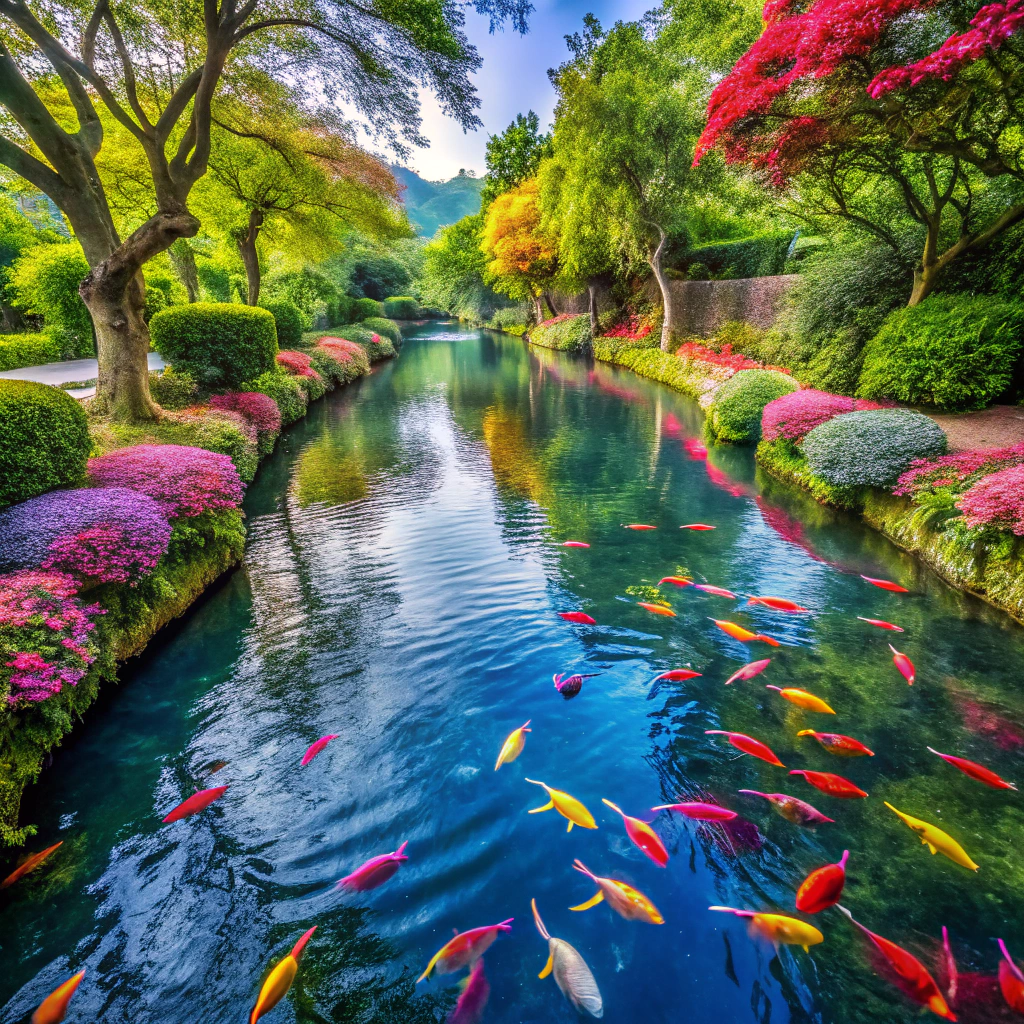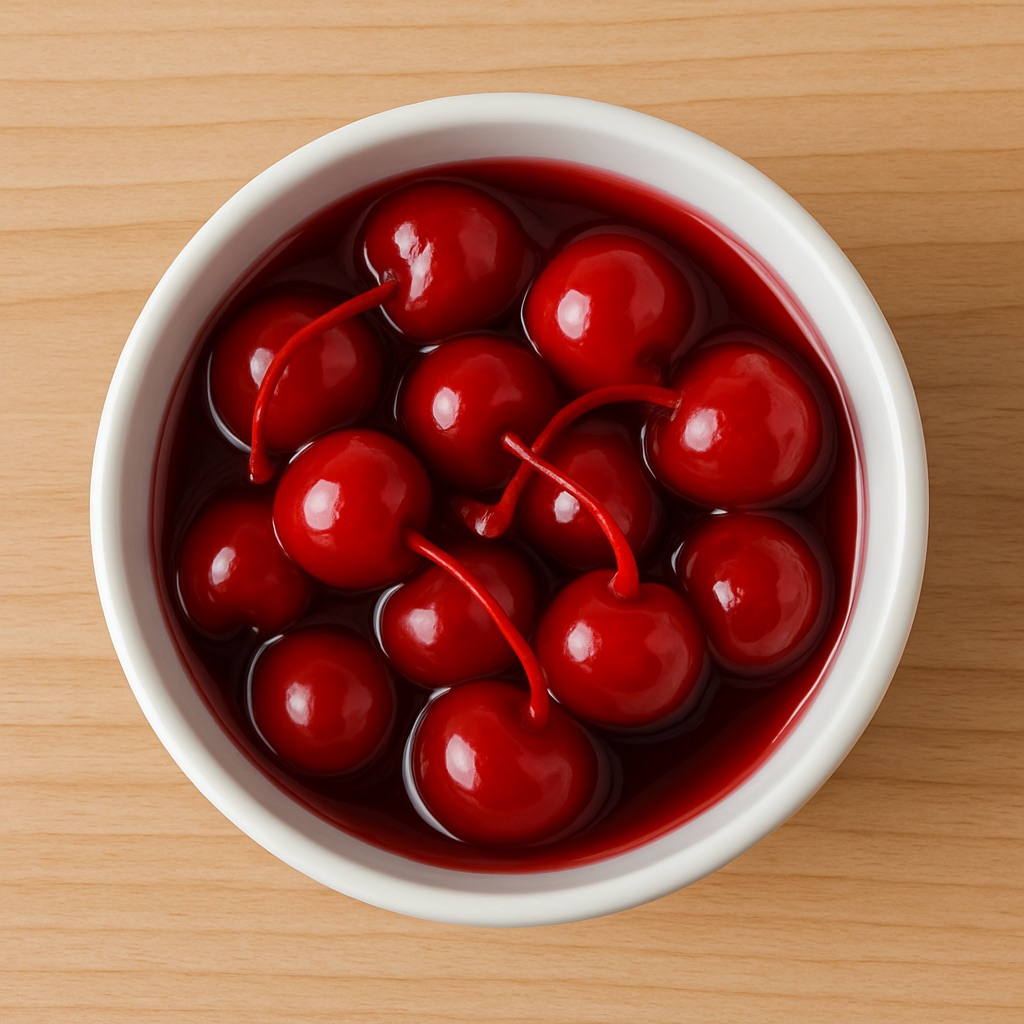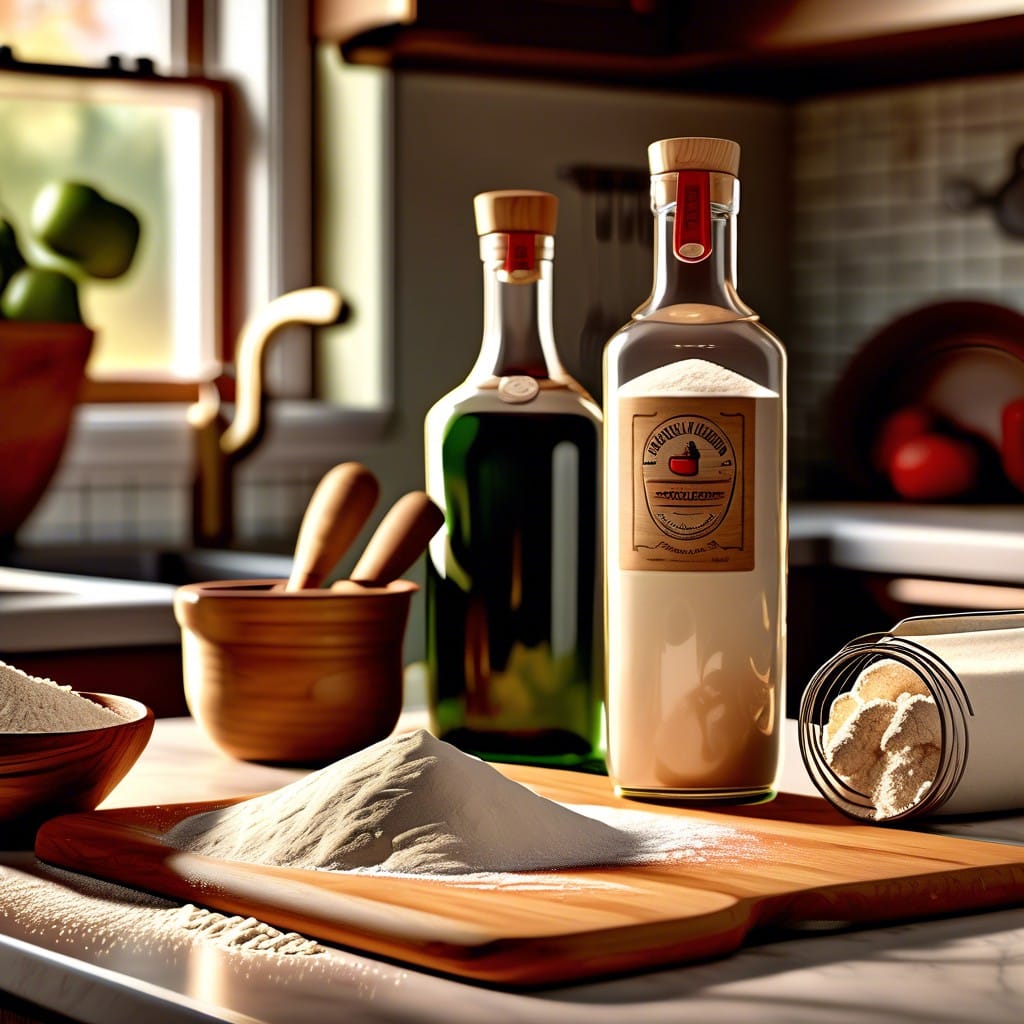Last updated on
Having a sparkling clean pool is easier than you might think, because this article provides a step-by-step guide to transform your green pool to crystal clear in no time.
Understanding the process to transform a green pool to crystal clear oasis involves steps such as pool circulation, shocking, and regular maintenance using the correct chemicals.
This process might seem daunting, but with a systematic approach and patience, it’s achievable by anyone, even if you’re not a pool professional.
This article provides you a thorough guide on how to accomplish this transformation, including identifying the cause of a green pool, selecting the right cleaning tools and chemicals, and providing clear steps for effective pool cleaning and maintenance procedures.
Here, you will find not just a superficial brushing off of the topic, but a comprehensive, step-by-step guide to help tackle a cloudy, green pool, and turn it into a sparkling clear haven.
Key takeaways:
- Identify the cause of a green pool: algae or copper ions.
- Regularly scrub and vacuum the pool to remove debris and prevent algae growth.
- Maintain and clean the pool filter to prevent algae growth.
- Test water regularly for alkalinity, pH, and copper levels and adjust as necessary.
- Use proper chemicals, such as chlorine, to treat the pool if needed.
Understanding the Steps for Cleaning a Green Pool

In maintaining a healthy and clean pool, certain steps need to be diligently followed. Here they are, simplified:
1. Identifying the Cause: This is step one in managing a green pool. Algae buildup or copper ions can cause the green discoloration. Pinpointing the cause helps in treating it effectively.
2. Regular Scrubbing and Vacuuming: This assists in removing physical contaminants and minimizing the likelihood of algae and other microorganisms thriving.
3. Filter Maintenance: The pool filter, if kept clean and in good working order, can help prevent a pool from turning green. Regularly backwashing and cleaning the filter can ensure it’s operating optimally.
4. Water Testing: Regular testing of water’s alkalinity, pH, and copper levels, if applicable, gives an understanding of the pool’s health and allows for necessary adjustments.
5. Proper Chemical Use: Depending on the test results, the routine use or even shock treatment using chlorine or other chemicals may be required.
6. Pool Covering: A clean and adequate cover can protect the pool from excessive exposure to the elements and unwanted debris.
7. Professional Help: If the green pool persists, it might be time to call in the professionals. Sometimes, stubborn green pools need more powerful treatments, which should always be a last resort.
Each of these steps contributes to a crystal clear pool. The journey from green to blue can be accomplished with consistent effort and understanding of pool care techniques.
Why Is My Pool Green?
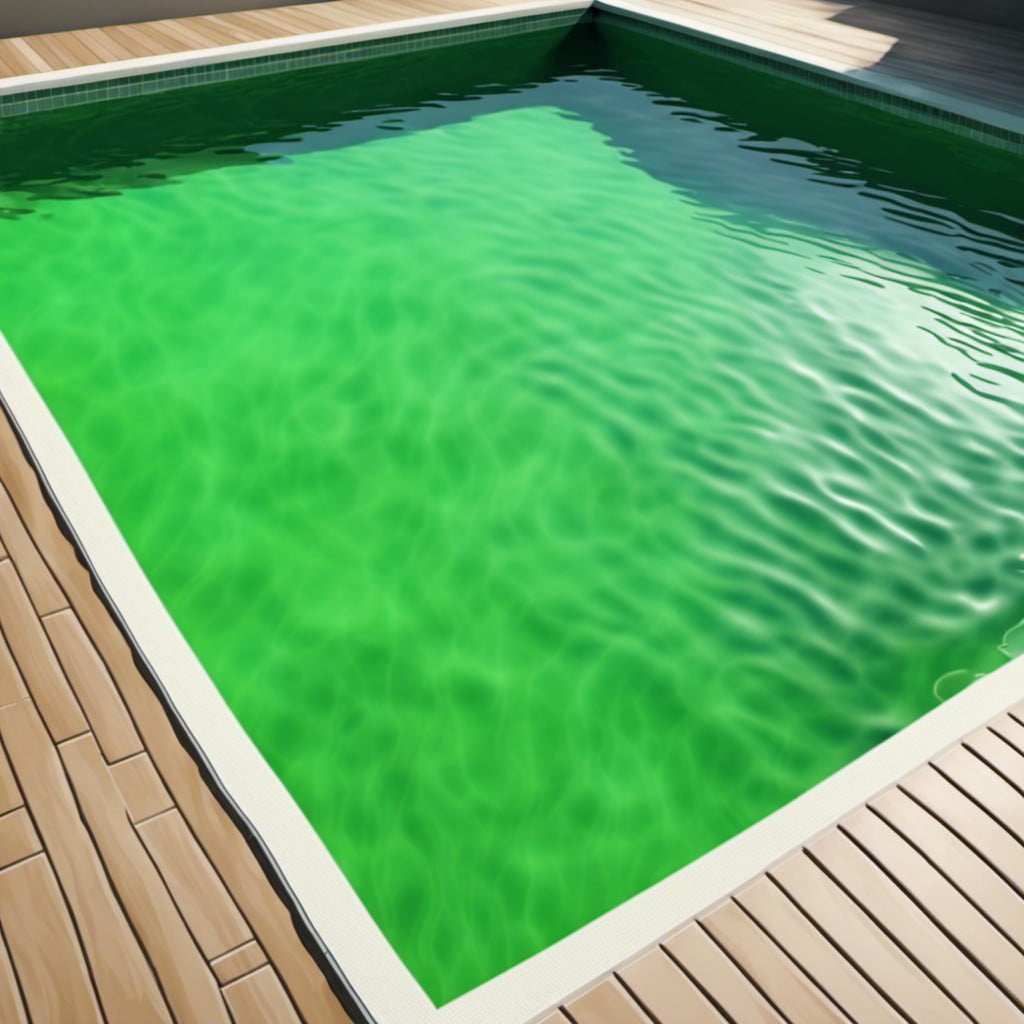
The common culprits behind a green pool are algae infestation, copper oxidation, or imbalanced pool chemicals. Algae blooms can quickly take over, discoloring the water as they multiply. Factors contributing to an algal takeover may range from neglected maintenance, improper circulation, or inconsistent sanitation procedures.
On the other hand, if copper-based algaecides have been used in your pool to stave off algae outbreak, copper ions can oxidize when exposed to the right conditions, such as chlorine and other certain pool chemicals. The aftermath of this oxidation results in a green tint to your pool.
Imbalanced pool chemicals, too, frequently tip the scales towards a green pool. For instance, if the pH levels in the water are too high, it may lead to decreased efficiency of your chlorine, allowing algae to prosper. It’s always good to remember that regular testing and correct balancing of the pool’s chemistry are essential for a clean, clear pool.
Non-Algae Cause of Green Pool: Copper Ions
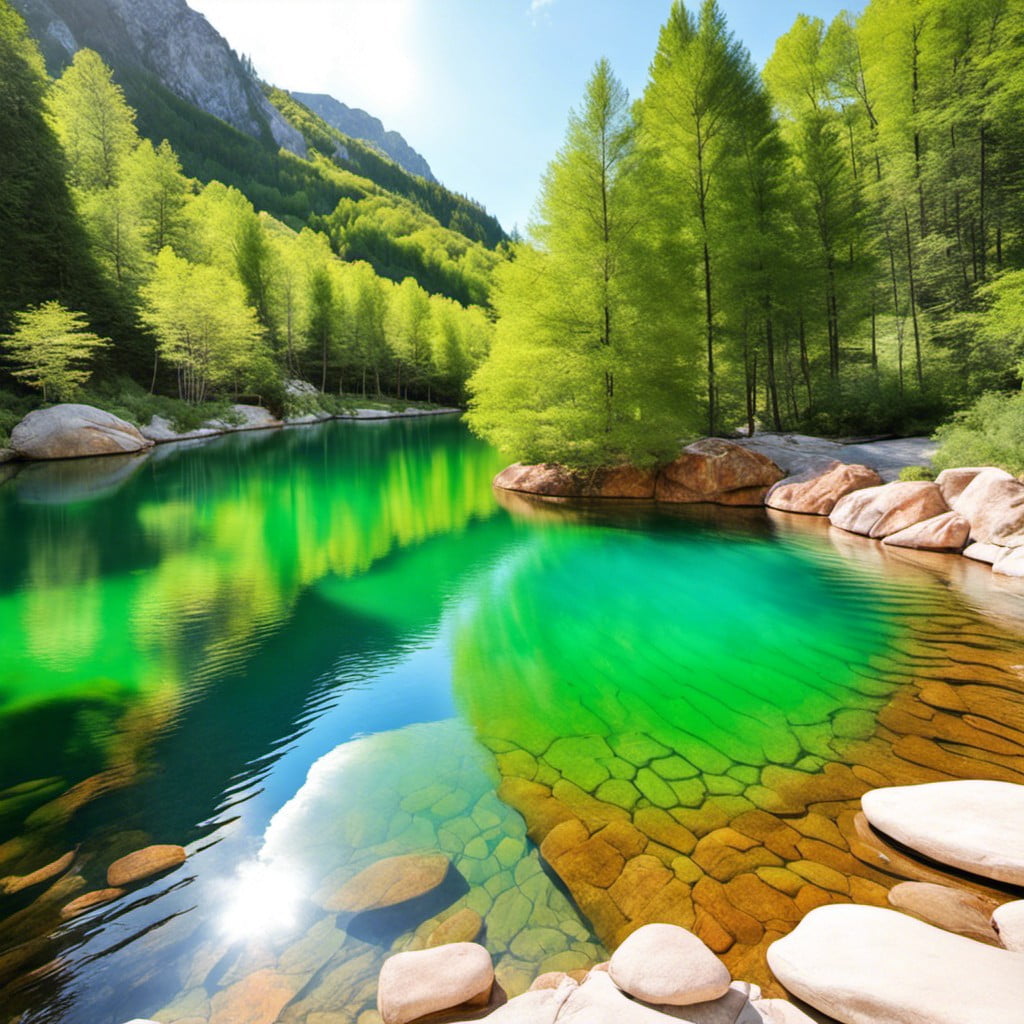
While discoloration in your pool often points towards an algae problem, that isn’t always the case. If your pool turns a deep, lush green color, especially after adding an algaecide or shock treatment, copper ions could be the culprit.
In pools, copper ions can originate from various sources including old or corroded copper pipes, copper-based algaecides, or even source water. When the copper ions in your pool water oxidize, they create a green color.
Copper oxidation in pools becomes more prevalent when the pH levels of the pool water goes towards the lower, acidic end of the scale. Acidic water corrodes metal, including copper, at a much faster rate.
Regular testing and adjustment of your pool’s pH levels can help prevent copper oxidation. Use a dedicated copper remover if copper is determined to be the problem.
Notably, high levels of copper in your pool can also stain the pool surface, swimwear, and even turn blond hair green, so it’s critical to address this issue promptly.
Remember, accurate testing methods are critical for identifying copper as the source of your pool’s discoloration. Rely on a good quality colorimetric test kit for the most accurate copper testing results. Professional services can also offer comprehensive water testing services, which could be an effective alternative if you’re unsure about the DIY approach.
The Role of the Pool Filter in Cleaning
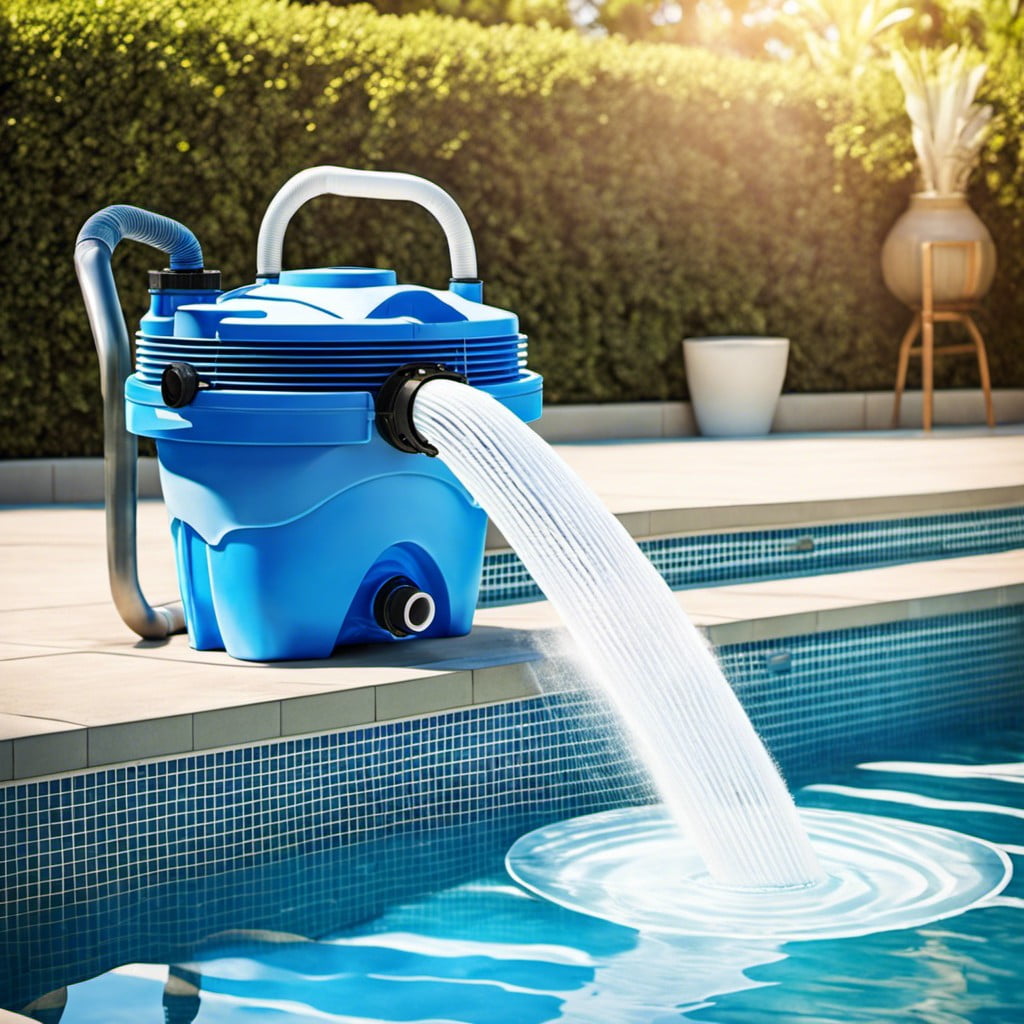
The pool filter serves an essential role in keeping pool water clean and clear. Its job is to remove fine debris, including algae, leaf particles, and dirt, that can turn pool water green.
There are three main types of filters used in pools: sand, cartridge, and diatomaceous earth (DE), each with their unique characteristics and cleaning needs.
First, the sand filter, a popular option, catches particles in its uniquely layered sand bed as the pool’s pump pushes water through it. When the pressure builds, it’s time for a backwash to remove the trapped debris.
Second, a cartridge filter, with a greater surface area, captures smaller particles than sand filters. These filters require occasional removal and cleaning with a hose, and replacement every three to five years.
Lastly, DE filters remove the smallest particles, even down to the size of algae spores. Like sand filters, they also require backwashing, but with an added step of recharging with fresh DE powder.
Pairing regular backwashing or cartridge cleaning with weekly basket cleaning from your skimmer and pump creates a robust filtration system. This balanced routine is crucial for removing those tiny debris particles that can cloud your pool’s water and allow algae to thrive. Proper use of the filter system maximizes your pool’s cleanliness, leads to crystal clear water, and makes your pool a pleasant place to spend time.
Brush and Vacuum Your Pool Regularly
Keeping the pool’s surfaces, bottom, and sides clean is crucial. Begin with a vigorous brushing session to dislodge any algae buildup. Use a pool brush attached to your pool’s telescoping pole, ensuring all areas are reached. Pay close attention to corners and stairs where debris often accumulates.
After brushing, proceed to vacuuming, which acts like your pool’s mop, picking up the debris dislodged after brushing. Manual vacuums are a good option for precision cleaning although automatic vacuum cleaners can be used for convenience.
Remember, both activities should be carried out at least once a week. This not only maintains your pool’s hygiene, but also influences the efficacy of your sanitizing chemicals, while enhancing water clarity. Regular pool brushing and vacuuming also extends the lifeline of your pool equipment, resulting in cost savings.
Testing Alkalinity & PH for Pool Health
Maintaining an optimal range for both alkalinity and pH levels is critical for the health of your pool. Alkalinity acts as a buffer to prevent spikes or drops in pH levels. It should be kept between 80 and 120 parts per million (ppm) to promote stability.
On the other hand, pH levels indicate how acidic or alkaline your pool water is. The ideal range sits between 7.4 to 7.6, allowing chlorine to work most effectively. Below 7.4, the water becomes acidic, causing metal parts to corrode and possibly irritating your skin and eyes. If it rises above 7.6, the water turns alkaline, leading to cloudy water, scale formation, and decreased chlorine effectiveness.
Testing these levels is a straightforward process using pool test strips or a pool testing kit. It’s important to carry out these tests at least once a week or after a heavy rain, significant top-ups of water, or heavy pool usage. Adjustments to alkalinity and pH can be made using chemicals available at pool supply stores. Remember to add these chemicals gradually and retest the water after every treatment to avoid overshooting the mark.
Importance of Testing for Copper in a Pool
Commonly found in tap water, copper can find its way into your pool, turning it a conspicuous shade of green. Metallic green as opposed to the regular algae-induced murky green. Copper ions oxidize when exposed to chlorine, and the process results in tinting your pool water.
Here is why and how you should check for copper in your pool water:
- Copper-Based Algaecides: While these are great for preventing algal growth, they introduce copper to the water. Regular testing can keep tabs on this.
- Copper Pipes: Older pool systems used copper for plumbing. Corrosion can introduce copper into the pool. Detecting it early can help minimize the damage.
- Test Kits: Simple and easy to use, kits for copper testing are available in the market. Follow the instructions closely for accurate results.
- Professional Testing: In case you find the DIY too daunting or time-consuming, you can hire professionals who are equipped with advanced tools to do the testing for you.
An understanding of copper presence in your pool aids in maintaining the pool health appropriately and addresses the mystery of the green tint before it escalates into a problem.
How to Double or Triple Shock the Pool
When undertaking a severe algae infestation, a standard dose of pool shock may not suffice. In such instances, doubling or tripling the amount of shock is often necessary. This process penetrates all layers of algae growth ensuring optimal disinfection. Make sure to use a high quality, strong-formula shock for best results.
Here are five key points to remember:
- 1. Determine the exact amount of shock needed by checking the instructions on the product label. Typically, it’s one pound per 10,000 gallons of water. Multiply this by two or three depending on how heavy the algae infestation is.
- 2. Before application, ensure the pool water’s pH level ranges between 7.2 and 7.4. A balanced pH ensures the shock treatment’s effectiveness.
- 3. Use a pool shock that contains at least 70% available chlorine. This higher strength chlorine solution will rid your pool of bacteria, algae spores, and other microorganisms.
- 4. Apply the shock in the evening to prevent the sun from breaking down the chlorine before it takes effect. Sprinkle the pool shock granules directly over the water surface. Avoid clumps as they can damage the pool liner.
- 5. Finally, ensure proper circulation of the shock. Running the pool filter system for at least 8 hours post-shock application will facilitate complete distribution and maximum effectiveness.
With these points in mind, the green menace doesn’t stand a chance against your triple shock treatment!
Dealing With Persistent Green Pool After Shocking
Despite properly shocking your pool, you might still grapple with a persistent green hue. Don’t sweat it. Likely culprits include inadequate filtration, imbalanced pool chemicals, or resistant algae strains.
Improve filtration efficiency by running the system for at least 8-10 hours daily. Regularly backwash the pool filter to remove trapped dirt or debris hindering its proper functioning.
Next, conduct comprehensive tests of the water chemistry. Ensure that total alkalinity, pH, and sanitizer levels are within correct ranges. A pH level between 7.2 and 7.6 and total alkalinity between 80-120 ppm (parts per million) favor easier pool clear-up.
For stubborn algae, consider using an algaecide. Apply the recommended dosage, following manufacturer guidelines for optimal results.
Lastly, brushing your pool daily will aid in algae removal, especially in problem areas such as corners and behind pool ladders where algae like to hide. A combination of these strategies will help conquer stubbornly green pool water.
Fixing a Green Pool Despite High Chlorine Levels
To handle a persistent green hue despite high chlorine levels, you’ll need to modify your approach. Firstly, high chlorine levels could point towards a high concentration of stabilizer (Cyanuric Acid), which curbs chlorine’s effectiveness. Therefore, reducing the stabilizer might be necessary.
Secondly, having the correct pH level is crucial. Chlorine disinfects most effectively with pH levels around 7.4 to 7.6. Too high or too low could minimize chlorine’s efficiency.
Thirdly, remember that non-organic material like sunscreens and oils can choke up chlorine, turning your pool green even with adequate sanitizers. Be cautious about what enters your pool.
Fourthly, it’s wise to target stubborn algae with an algaecide. A copper-based one is preferable, considering it stays longer in water and offers better prevention against future algae blooms. But remember, excessive copper can turn your pool green too; therefore, use it wisely and only as a supplement to chlorine, not a substitute.
Lastly, routine brushing helps remove algae sticking to pool walls, giving the chlorine a better chance at disinfecting the pool. Regular brushing could be the difference between a green and a sparkling pool. So, don’t overlook it.
Role of a Clean and Adequate Pool Cover
An effective pool cover holds two significant responsibilities. First, it serves to prevent debris such as leaves, dust, and insects from contaminating the pool, thereby reducing the burden on your filtration system. This helps maintain water clarity and reduces the risk of algae formation. A cover also keeps rainwater, which often carries pollutants and algae spores, from entering your pool.
Second, a pool cover acts as a measure against unnecessary water loss by reducing evaporation, especially in the hot summer months. This helping to maintain the water’s chemical balance and prevents the need for constant topping up, potentially saving on water bills.
When choosing a pool cover, ensure it fits your pool’s dimensions adequately. A poorly fitting cover leaves room for debris to find its way into the pool. Some materials, like mesh, allow water to pass through but block leaves and other larger debris. This can be beneficial in regions where it rains frequently.
Periodic cleaning of your pool cover is also important as a dirty cover can pollute the water as soon as it’s removed. Use a pool cover cleaner or mild detergent and rinse thoroughly.
Remember, a pool cover is a preventive maintenance tool and not a fix to a green pool. If your pool has already turned green, appropriate steps should be taken to restore water quality and balance before employing the pool cover for preventive measures.
Importance of Regular PH Checks Even in Winter
Maintaining a balanced pH level in your pool is essential, even during the colder months. This balance helps ensure the water remains clean and clear, protecting both the pool equipment and the swimmers’ health.
1. Consistency: Regular checks allow for quick adjustments, keeping pH levels between 7.2 and 7.6, the ideal range for pool water.
2. Protection: An improper pH level can damage your pool liner and equipment. It can be corrosive if it’s too low or can cause scaling on your pool surface and equipment if it’s too high.
3. Swimmer Comfort: Balanced pH levels prevent skin and eye irritation for any winter swimmers, contributing to a comfortable swimming environment.
4. Effectiveness of Pool Chemicals: Chemicals used in pools, like chlorine, are most effective when the pH is balanced. An imbalanced pH may lead to poor disinfection, leading to bacterial or algae growth.
Regular checks, therefore, serve as a preventive measure, ensuring your pool is ready for use as soon as warmer weather returns.
Preventing Pool Algae From Returning
Continual vigilance is key in any algae fight. Regular checking of the pool’s chemical balance, once a week in the summer and every 2 weeks in the winter, helps keep the water crystal clear. Aim for these values: pH levels of 7.2-7.6, total alkalinity of 80-120 ppm, calcium hardness as per manufacturer’s recommendation, and cyanuric acid levels at 30-50 ppm for outdoor pools.
Daily skimming can help remove organic debris before it begins to decay and turn into a food source for algae. A weekly thorough brushing of walls and floors prevents algae accumulation and keeps chlorine working effectively.
Consider a pool sanitizer with algicidal properties, or separate weekly algaecide treatments. But remember, these are not substitutes for shock treatments.
Use a pool cover when you’re not swimming; algae love the sun! Pool covers also hinder debris from entering the water, the less organic matter, the less food for algae.
A vigilant pool maintenance routine will minimise algae resurgence, resulting in sparkling clear and healthy pool water!
Understanding the Role of Pool Phosphates
Phosphates, present as microscopic particles in your pool water, can encourage algae growth. Originating from several sources, such as rainwater, soil runoff, or even swimmer waste, these phosphates provide a hearty feast for algae.
Generally, pools with phosphate concentrations exceeding 1000 parts per billion (ppb) are prone to murky-green water due to rampant algae growth. To verify the levels, carry out a pool water test. Kits are readily available for this purpose.
It’s crucial to maintain low phosphate levels. Numerous commercial phosphate removers can assist, such as lanthanum compounds or rare earth salts. They’re easy to use – just follow the manufacturer’s instructions. After treatment, it’s advisable to meticulously brush and vacuum your pool to eliminate dead algae. Regular testing and treatments ensure phosphate levels remain under control to maintain the crystal clear status of your pool.
Maintaining Clear Pool Water: Effective Tips
A crucial tip for preserving pristine water is consistent chlorination. Chlorine not only sanitizes but also promotes oxidization, which is vital to get rid of contaminants. Ensure to keep your pool’s chlorine levels between 1.0 and 3.0 parts per million.
An effective pool circulation system facilitates the dispersion of chemicals, directing dirt and debris to the filter to prevent stagnation and cloudiness. Keep your pool pump running for at least 8-12 hours a day for optimal circulation.
Mind your pool’s pH level. Aim to keep it between 7.2 and 7.8. This range promotes maximum efficiency for the chlorine in your pool and is gentle on the swimmer’s skin and eyes.
Regularly skim and vacuum your pool. Skimming the surface every few days goes a long way in maintaining a clean and clear pool. Likewise, vacuuming once a week helps remove the contaminants that the skimmer misses.
An often overlooked tip is to maintain cleanliness around the pool. Rinse off the pool deck and nearby areas frequently to prevent wind-blown debris and dirt from entering the pool.
Clean the pool filter as a part of your regular pool maintenance. A clogged filter can lead to several issues, including a green pool. Depending on the filter type, you will need to backwash or physically cleanse it.
Last but not least, professional pool inspections can be advantageous. They can spot and fix minor issues before they turn into costly repairs and help in maintaining clean pool water.
Understanding How to Clear Green Pool Water Fast
For rapid transformation, kick-start the process with a hefty dose of pool shock, a concentrated chlorine. Typically, you’ll need a pound of this granular compound for every 10,000 gallons of pool water. Remember, it’s important to evenly spread the shock across the pool’s surface. Take extra caution to not let it settle at the bottom as it can bleach your liner. After all, we’re aiming for clear water, not a bleached pool bottom!
Post shocking, circulation is key. Keep your pool running 24/7 until the green hue vanishes completely. This helps in better distribution of the shock, facilitating an effective sanitization process. The filter system should remove the dead algae once chlorination kills them.
Use a reliable test kit to confirm sanitizer levels. Aim for a chlorine concentration of 5 ppm and pH near 7.2. If pH is off-kilter, fix it with pH decreasers or increasers beforehand. This ensures efficient chlorine sanitization.
Lastly, scrubbing and vacuuming the pool’s floors and walls can help speed up the process. Get rid of dead algae and debris ensuring water clarity.
Well, speed and efficiency are in your hands now. Let’s get to it!
Routine Pool Filter Cleaning for a Clear Pool
Ensuring meticulous cleanliness in the filter system is pivotal in maintaining the clarity of your pool. An unclean filter can hinder proper water circulation and lead to increased green algae accumulation.
Here are some points to guide you.
1. Identify Your Filter Type: Your pool will either have a cartridge, sand, or diatomaceous earth (DE) filter. Each requires a unique cleaning procedure – know what you’re working with.
2. Regular Inspection and Clean Up: Ideally, this should be done weekly. Check all parts, especially the pumps for any blockage and clean accordingly to ensure smooth operation.
3. Backwash Sand and DE Filters: This involves reversing the flow of water to flush out the dirt and debris. Though it’s generally done every few months, monitor your pool’s clarity to determine the optimum frequency.
4. Replace Filter Media Annually: Sand and DE need to be changed once a year. Cartridge elements, given proper care, can last between 2-3 years before replacement is needed.
5. Give the Professionals a Call: If unsure about the cleaning process or if the filter system is too complicated, don’t hesitate to hire a professional pool maintenance company – your crystal clear pool will thank you for it.
By adopting these recommendations, a clean filter system will contribute significantly towards keeping your pool water sparkle, reduce the rate of algal growth, and ultimately, transition from green to that beautiful clear hue.
Importance of Regularly Testing and Tweaking Your Pool’s Chemistry
Ensuring optimal chemical balance in your pool is paramount to maintain a crystal clear water quality. Here’s why it’s crucial:
1. Sanitation: Regular testing helps monitor the chlorine level in your pool, the primary disinfectant that eliminates bacteria, algae, and other contaminants.
2. Comfort: Balanced chemistry promotes swimmer’s comfort by preventing skin and eye irritation often caused by excessive chlorine or pH imbalance.
3. Equipment Protection: Correct chemical levels prevent corrosive or scaling effects on the pool infrastructure. High acidity can damage the pool liner and equipment, while high alkalinity can result in scaling and cloudy water.
4. Efficient use of chemicals: Knowing your pool’s precise chemical status means you add just the right amount of chemicals – not more, not less. It’s an economical approach and eliminates the guesswork.
Remember, testing should be frequent – at least once or twice a week – and always after abnormal situations such as heavy rain or pool party. Digital testers or test strips can be your go-to tools for this task. After testing, adjust your pool’s chemistry accordingly. It’s about staying proactive to keep your pool inviting all year long.
Understanding the Effect of Rain On Pool Coloring
Rainfall can significantly alter pool water chemistry. Primarily, it dilutes the water, subsequently decreasing the concentration of sanitizing chemicals. This can pave the way for algae bloom, turning your pool water green.
Additionally, rain often contains atmospheric pollutants and microorganisms. When these find their way into your pool, they can contribute to discoloration while also making the water unsafe for swimming.
Heavy rain can also lead to runoff from surrounding plants and soil into your pool. This debris introduces additional contaminants which contribute to coloring and perhaps even the growth of algae and other microorganisms.
Lastly, the cool temperature of rainwater may lower your pool’s overall temperature, slowing down the efficiency of many sanitizing chemicals, and leaving space for algae to flourish.
Regularly testing your pool after heavy rainfall is, therefore, crucial to ensure it remains crystal clear and safe for use.
Professional Pool Cleaning Services Vs DIY Cleaning
Selecting between a professional pool cleaning service and a DIY approach largely depends on several factors such as available time, expertise, and budget.
A significant advantage of a professional service is the level of expertise offered. These experts not only clean your pool but also identify potential issues that may escalate if ignored. Even complex procedures such as shocking and water chemistry balancing are handled efficiently. However, these services come at a cost and may be needless if your pool requires only basic maintenance.
On the other hand, opting for DIY cleaning can save on costs, and with a plethora of online resources, tutorials, and tools available, it is quite achievable. However, a lack of professional knowledge may lead to overlooking critical problems.
Alternatively, a combined approach can be adopted. Meaning, you could manage routine tasks and hire professionals for complex tasks or periodic deep cleanings. This approach combines the benefits of both methods. However, remember that maintenance is a continuous process, and keeping a stringent schedule is vital. So, consider your decision wisely.
Is Swimming Safe in Green Pool Water?
Diving into a green pool might seem tempting on a hot day, but it’s not recommended. The green color indicates a high level of algae, which in itself might not be harmful, but the environment supporting their proliferation surely is.
This habitat promotes harmful bacteria like E.coli, which could potentially result in gastrointestinal or skin infections.
Additionally, if the pool’s chlorination is off balance, it can cause skin and eye irritation even on brief exposure. Improper chemical levels can also make the water cloudy, reducing visibility and increasing the risk of accidents.
Moreover, a high concentration of copper – another reason for green water – might turn your hair green. So, next time when the pool appears even slightly green, it’s best to roll back your swimming plans until the issue is resolved.
Regular pool maintenance will ensure the water remains enticingly blue and safe for swimming.
The Journey: Green to Blue Pool in 4 Steps
Kicking off this transformation, the initial action is to clear the pool of debris using an efficient skimmer net. This helps to make the subsequent steps easier by reducing the extent of obstructions in your cleaning process.
Next comes the important process of balancing the pool’s chemical levels. Ensure pH levels are within the range of 7.4-7.6, and adjust alkalinity to maintain between 80-120 ppm. This balance discourages algae growth and prepares the pool for shock treatment.
Once appropriately balanced, shock your pool with a heavy dose of chlorine. Depending on the severity of the algae invasion, multiple shock treatments may be necessary. Remember to follow the safety instructions on the product’s label to avoid injuries or damage to the pool surface.
Lastly, scrubbing and filtration come into play. Rigorously brush pool walls and floors to release stubborn algae, followed by a thorough run of the pool filter. This step might need to be repeated for the best results. Regular monitoring of the pool filter and adjusting filtration run-time is essential to ensure all microscopic algae particles are eliminated.
Eco-Friendly Ways to Clean a Green Pool Without Chemicals
Opting for eco-friendly solutions is an excellent way to maintain your pool’s cleanliness without relying heavily on harsh chemicals. Here’s how you can achieve it:
1. Balance pH Levels: Regular monitoring of pH levels remains crucial, as imbalance can lead to algae growth. The ideal range is between 7.4 and 7.6.
2. Use a Solar Cover: A solar cover can reduce water and heat evaporation, limiting the growth of algae. It’s a simple yet effective way to maintain pool health.
3. Utilize a Robotic Cleaner: A robust pool cleaner can scrub walls and floor, removing algae without additional chemical treatments.
4. Implement Baking Soda: Baking soda is a fantastic alternative to harsh chemicals for adjusting the alkalinity in your pool. It’s safe, non-toxic, and effective.
5. Apply Natural Pool Clarifiers: Consider using natural pool clarifiers such as chitin-based products. They help filter small debris, preventing accumulation that often causes discoloration.
6. Install UV or Ozone System: While costlier upfront, both UV and ozone systems drastically reduce the need for chemical usage by destroying harmful microorganisms.
Remember, these methods can be less potent than traditional chemical treatments but treating your pool naturally is a good step towards an eco-friendly lifestyle. Regular monitoring and prompt attention to any issues that arise can make these methods more effective.
Role of a Robotic Cleaner in Pool Maintenance
Automation has revolutionized pool maintenance, thanks to the advent of robotic cleaners. These devices work independently from the pool’s main filtration system, effectively reducing the load on the pump. Armed with built-in filters, they’re capable of collecting debris, scrubbing the walls, and vacuuming the floor.
No task is too daunting; they tackle dirt and algae with gusto, reaching areas that manual or suction cleaners might miss. Their sophisticated mapping technology scans and memorizes the pool layout for comprehensive coverage.
Energy-efficient, they use less electricity than traditional pumps, promoting an environmentally friendly clean. Furthermore, the pool’s chemical balance is better maintained since there’s less backwashing from the main filter, leading to a lower chemical usage.
Regular use of a robotic cleaner can also boost the longevity of your pool finish, by minimizing the build-up of harmful chemicals and algae. However, keep in mind that robotic cleaners are not a substitute for regular water testing and adjustment of pool chemistry.
Essential Maintenance Chemicals for a Sparkling Pool
To ensure the brilliance and hygiene of your pool water, several critical maintenance chemicals are a must. First amongst these are sanitizers, often Chlorine or Bromine, integral for destroying harmful bacteria.
Algaecides thwart the growth of algae that can cloud and slicken your pool, drastically reducing its visual appeal and safety. Clarifying agents are another ally in your defense against murky waters. They work by coagulating minute impurities, making them thick enough for the filter to catch.
Balancing chemicals, although not directly cleaning agents, play a significant role. They keep the pH and alkalinity levels in check, averting potential damage to the pool equipment, and ensuring other chemicals work to their full potential.
Stain preventers can retain the pool surface’s pristine appearance by counteracting stain-forming elements such as iron and copper. Lastly, shock treatments help to eradicate bacteria and other impurities that accumulate over time – consider it as a rigorous, deep clean for your pool.
Remember, regular and considered usage of these chemicals is a guarantee to a shimmering, healthy pool.
FAQ
What dissolves green algae from pool?
To dissolve green algae from a pool, the use of pool shock is recommended, as it raises the free chlorine levels and effectively kills the algae.
How long does it take a green pool to clear up after being treated?
After treatment, a green pool typically clears up within a span of 3 to 14 days, considering daily chlorine shocks and constant filtration.
How much chlorine does it take to clear a green pool?
To clear a green pool, perform a super-chlorination using 10-20 parts per million (ppm) of fast-acting liquid chlorine which won’t increase levels of cyanuric acid or calcium in the water.
Will vinegar clear a green pool?
Yes, vinegar can clear a green pool as it is effective in removing algae and other growths.
What techniques are effective in preventing green algae growth in pools?
Effective techniques for preventing green algae growth in pools include maintaining proper pH and chlorine levels, regularly cleaning and scrubbing the pool, ensuring good water circulation, and using algaecide chemicals as needed.
Does maintaining a specific pH level help in keeping the pool clear of green algae?
Yes, maintaining a specific pH level between 7.2 and 7.8 helps keep the pool clear of green algae.
Can ultraviolet sanitizers contribute to a green pool’s speedy recovery?
Yes, ultraviolet sanitizers can aid in a green pool’s speedy recovery by destroying harmful bacteria and algae.
Recap:
